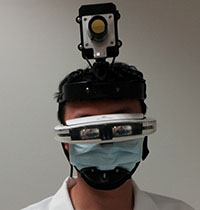


Posted November 18, 2013
Yang Liu, Ph.D., The University of Akron
 What is the most important thing(s) to know about your BCRP-funded research?
What is the most important thing(s) to know about your BCRP-funded research?
Our BCRP-funded research has led to important discoveries about breast-conserving surgeries and cancer staging using the fluorescence goggle device. We have developed several prototype fluorescence goggles, which are real-time imaging and display systems to guide surgeries (see figure below). We have demonstrated that the fluorescence goggle can intraoperatively identify the extension of breast tumors, residual tumors, and small nodules, which are not obvious to clinicians by conventional assessment. We have also demonstrated that the fluorescence goggle can facilitate sentinel lymph node biopsies and telemedical collaboration. Intraoperative imaging aided by the fluorescence goggle system has been successfully performed on rodents, rabbits, and human patients. The fluorescence goggle holds great promise for improving surgical outcomes, reducing breast cancer relapse, and delivering quality care to underserved populations.
What led you to this research question?
As biomedical engineers, our goal is to develop better technologies to serve clinicians and patients. Cancer recurrence due to incomplete resection is a devastating problem. The lack of an accurate intraoperative imaging system for breast cancer not only leads to additional follow-up surgeries, but also poses a life-long risk of cancer relapse on patients. The desire to improve surgical outcomes and save lives led us to research in this direction.
How is your research accelerating progress toward ending breast cancer?
Our research is accelerating progress toward ending breast cancer through our innovations in intraoperative imaging and image-guided surgeries. To date, surgery remains the primary curative treatment for localized and regional breast cancer. By providing surgeons with accurate functional image guidance, surgeries can become more accurate and effective in the short term. With our future efforts in intraoperative imaging instrumentation, in the long term we can potentially promote surgical medicine from a palliative treatment to a curative treatment for advanced breast cancer to save more lives.
What is the next step to bringing your research closer to helping patients with breast cancer?
The next step is to further develop the intraoperative imaging technologies and to translate the technologies into clinical settings. We would like to develop novel technologies to help advanced breast cancer patients. We believe that the interdisciplinary collaborative research integrating optical instrumentation and materials science will enable us to realize image-guided management of breast cancer metastases. We will develop technologies to prevent, manage, and potentially eradicate metastases through enhancing the power of surgical medicine. We would next translate our technologies to clinical studies to help breast cancer patients.
How has this BCRP funding helped advance your research?
With BCRP support, I was able to carry out high-risk transformative research that has the potential to shift the current paradigm. With BCRP support, I have had opportunities to conduct interdisciplinary studies spanning from instrumentation, materials science, biology to surgical medicine.
How did this award help you advance in your career in breast cancer research?
The BCRP Predoctoral Traineeship Award provided the opportunity for me to receive rigorous training at Washington University under the mentorship of Dr. Samuel Achilefu and prepared me as an independent breast cancer researcher. The BCRP provided me with an excellent platform to conduct research at the frontier of innovation. I completed my Ph.D. study in 5 years. Half a year before my award period was completed, I received a tenure track faculty position as assistant professor in the Department of Biomedical Engineering at the University of Akron. My BCRP award has prepared me well for my career as an independent faculty member leading an interdisciplinary lab.
Currently, I lead the Optical Diagnostics Laboratory in the Department of Biomedical Engineering at the University of Akron. My research program focuses on optical instrumentation, intraoperative imaging, and image-guided therapies. The overall goal of my program is to bring novel medical technologies from the benchtop to the bedside of patients. I am developing interdisciplinary approaches interfacing optics, electrical engineering, systems engineering, materials science, and medicine to solve challenging medical problems. Along with the departmental culture of UA-BME, which highly values patient-centered innovations, our research program aims at improving breast cancer management using engineering principles.

Publications:
Liu Y, Zhao Y-M, Akers W, et al. 2013. First in-human intraoperative imaging of HCC using the fluorescence goggle system and transarterial delivery of near-infrared fluorescent imaging agent: a pilot study.
Translational Research 162(5): 324-331.
Liu Y, Njuguna R, Matthews T, Akers WJ, Sudlow GP, Mondal S, Tang R, Gruev V, Achilefu S. 2013. Near-infrared fluorescence goggle system with CMOS imaging sensor and see-through display. Journal of Biomedical Optics 18(10):101303
Liu Y, Bauer AQ, Akers WJ, Sudlow G, Liang K, Shen D, Berezin MY, Culver JP, Achilefu S. 2011. Hands-free, wireless goggles for near-infrared fluorescence and real-time image-guided surgery.
Surgery 149(5):689-698.
Links:














